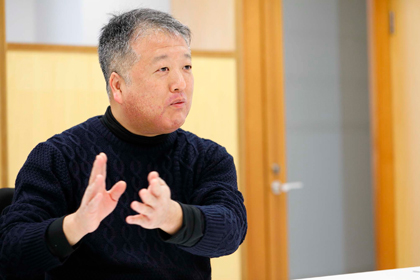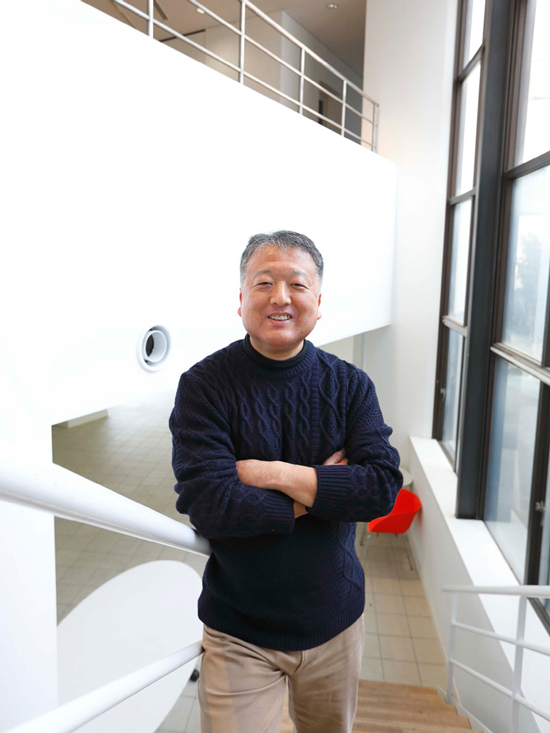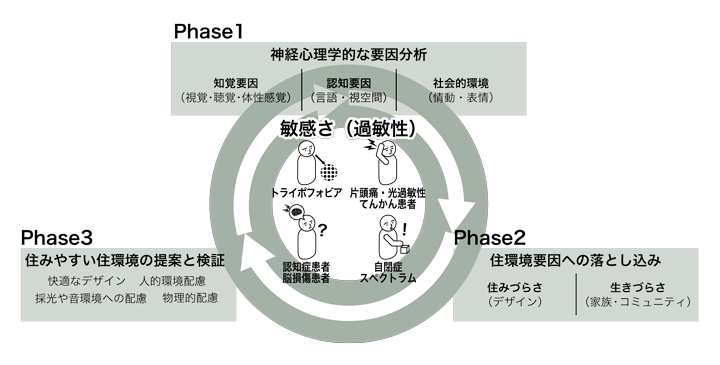TSUKUBA FRONTIER
#025 The Brain, the Heart, and Design: Uncovering What Makes Each Unique Person Feel Comfortable
Professor KOYAMA Shinichi, Faculty of Art and Design

Some people are made comfortable or uncomfortable by certain shapes, patterns, or light. We tend to write this off as preference or taste, but extreme sensitivities can even interfere with people's daily lives. Prof. Koyama is working to uncover the mechanisms by which we understand sensory information in order to create spaces where people with all kinds of perceptions of "comfortable" can coexist.
■ Searching for the True Nature of ComfortLooking at a picture of a human face with a dot pattern printed on it makes people uncomfortable for whatever reason. Some people may even feel disgusted. These kinds of manipulated images are called trypophobic images. The word comes from the Greek word "trypo," which means "punching holes," plus "phobia," which means "fear."
A considerable number of people are sensitive to certain patterns such as dots or stripes, which can manifest as aversion or, conversely, strong attraction. In extreme cases, a person may feel so uncomfortable looking at stripes that they will not walk through a crosswalk, or are so blinded by sunlight or neon signs that they cannot go outside. These extreme aversions cannot be explained away by saying that human senses are strange.
Discomfort and aversion are not easy to explain in words. Prof. Koyama is working on a research project to uncover the mechanisms by which people perceive visual information as pleasant or unpleasant through various lenses, including neuroscience, psychology, and even interior design.
■ Quantifying Discomfort

Discomfort can be quantified by metrics such as the duration of unpleasant feelings or by heart rate, and the strength of the feeling can be measured by comparison against standard levels of discomfort. This approach of trying to understand changes in emotion quantitatively comes from psychophysics.
Experiments have shown that increasing the number of dots over the same surface area causes greater discomfort. However, turning the image of the face with dots upside down reduces feelings of discomfort.
There are two possible hypotheses that could explain this. The first is that the brain is programmed with the ability to perceive the size and density of the dots. The second is that this is a defense reaction we have as animals. The logic behind this hypothesis is that a dot pattern on a human face could be a sign of an infection or other such disease, which could cause us to attempt to avoid that person based on instinct or experience. However, when the face is turned upside down, it is more difficult to recognize as a human face and consequently makes us less uncomfortable.
■ Reading Sensitivity from Brain WavesInjuries to certain parts of the brain can cause people to lose the ability to recognize human faces or written language. The fact that people feel comforted or uncomfortable when exposed to certain shapes or light could also be thought of as some kind of overreaction of information processing in the brain that controls a person's sensitivity.
However, examination of the brain waves of people who suffer from such sensitivities by electroencephalography (EEG) showed no obvious alterations. These people seem very distressed, so you would think there should be dramatic differences, but looking at EEG results alone did not show any particular abnormalities. It may be that the process of intake and processing of visual information by the brain that occurs before manifestation as sensation is extremely faint, or that the reaction is occurring somewhere unexpected. It seems that more research still needs to be done on this topic.
■ Between Hypersensitivity and Hyposensitivity
Although a relatively large number of people are disgusted by trypophobic images, naturally some people don't think anything of them. It is not uncommon for even people who become very irritated by bright light to barely show any reaction to other stimuli. Perception also changes with mental state and the surrounding environment at the time. In addition, unpleasantness and pleasantness are not always opposites: we know that there is definitely an intermediate sensation of something being "adorably disgusting." Hypersensitivity and hyposensitivity coexist, and it is difficult to conceive of them as separate. This kind of thing is what makes this field of research complex and difficult, and that can make it interesting as well.
■ To the Cutting Edge of Universal DesignDifferences in sensitivity are not easily understood by those not affected, and are currently not readily recognized as disabilities. Is it possible to design spaces where everyone can coexist when some people are distressed by information or environmental conditions that most people do not think twice about?
For example, if the lights in the space were dimmed for people hypersensitive to light, it would then cause a problem for people with low vision but it is not practical to separate the space. Maybe proactively providing positive stimuli rather than eliminating negative stimuli would make the people in the space happier. To ensure that people who have hypersensitivities can coexist with people who do not, it will be important to think about interior design beyond the current concept of universal design, and what kinds of individual countermeasures should be put in place.
Research to uncover the mechanisms of sensitivity and unpleasantness from a scientific perspective, discover methods for treating hypersensitivities, and support people currently struggling will all make contributions back to society. This research integrating perspectives from different fields should lead to designing environments where anyone can spend time comfortably.

Japan Society for the Promotion of Science
Topic-Setting Program to Advance Cutting-Edge Humanities and Social Sciences Research (Area Cultivation)
Exploration of "humanities and social science for symbiotic society" driven by neuropsychology of hyper brain functions
The research project is progressing through the following three phases.
Phase 1: Identify factors that cause various kinds of sensitivity and uncover the mechanisms of how the brain responds to sensitivity by studying young subjects as well as patients with dementia and brain injuries.
Phase 2: Analyze the problems that sensitivity causes in daily life based on results of Phase 1.
Phase 3: Design and test living environments where people who have hypersensitivities can live comfortably alongside people who do not based on results from Phase 2.

Article by Science Communicator at the Office of Public Relations


